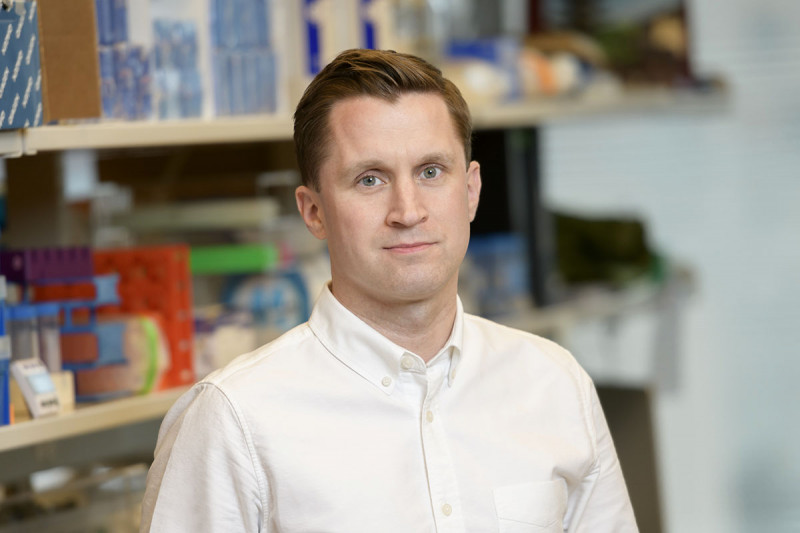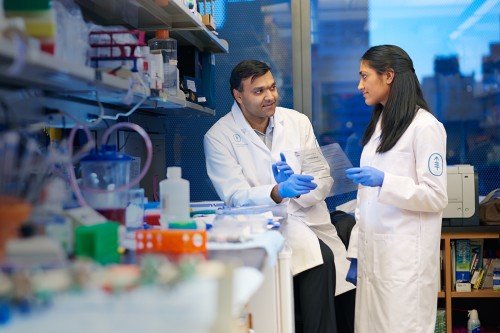
I grew up in the suburbs of Annapolis, Maryland. My dad worked for the Small Business Administration, which is part of the federal government. My mom was a high school science teacher, and she encouraged my early interest in science. One fond memory is how my brothers and I would assemble large and elaborate insect collections every summer.
Growing up, I originally wanted to be an architect. I also really liked art and the humanities. I’m not sure what first got me into medicine. I think it was probably curiosity about how the immune system can fight off infections and infectious diseases.
When I went to college, at the University of Maryland, Baltimore County, I majored in biochemistry, with a premed focus, and minored in Spanish. Entering college, I probably had a stronger background in English and history than I did in science. But when I started to do college-level biochemistry, I just fell in love with it. I loved the courses and the clarity of the problems.
I did a summer undergraduate research program at New York University. That’s when I found out about MD/PhD programs. That trajectory appealed to me: being able to have a bigger impact, on a broader scale, by doing research that could change the way that medicine is done.
I decided to do my PhD in immunology at the University of Pennsylvania, where I joined the lab of Steve Reiner. He was studying how transcription factors control the differentiation of T cells. I studied two particular transcription factors. What I found is they control the decision about whether to become a short-lived killer cell or a memory cell. Memory cells last your whole life and can mediate long-term immunity. I was very interested in the question of how cells make decisions.
At that time, Craig Thompson was also at Penn, and I was hearing a lot about his research. I became more and more interested in metabolism. I considered staying at Penn to do a postdoc with him, but for a variety of reasons, my wife and I wanted to be in New York City.
Then when I was in residency, I found out that Dr. Thompson was becoming President of MSK. That’s when I knew that I had to do my postdoc with him.
A New Role for an Old Player
It was right around then that the IDH mutations were discovered. Dr. Thompson and others had figured out that the mutations make a metabolite that can disrupt the decisions that stem cells make and cause cancer. That was just fascinating to me — that a tiny five-carbon metabolite could completely change a cell’s fate. When the IDH mutations were discovered, no one thought these boring housekeeping genes could be cancer drivers. I came into the lab wanting to attack metabolism from that angle: How do these metabolites affect the decisions that cells make?
When I was trying to figure out what my project would be as a postdoc, a couple of things intrigued me. One was the fact that this metabolite, 2HG, is not really one metabolite. It’s actually two different ones — they’re enantiomers [mirror images] of each other. The cancer-associated mutations make one of the mirror images, called the D enantiomer. When people were trying to figure out what the D enantiomer did, they were using the other enantiomer, called L, as a control. Unexpectedly, they found that the L enantiomer is much more potent. No one knew what to make of this. But because cancers don’t make the L enantiomer, people didn’t seem that interested in finding out.
The other thing that I found fascinating was that there are waste disposal enzymes for both of those metabolites. They’re enantiomer-specific and conserved throughout evolution. Kids born with deficiencies in either of those waste disposal enzymes suffer from severe developmental pathologies, neurologic devastation early, and an early death. But the kids missing the L disposal enzyme also get brain tumors. So that told me that normal cells must be making the L form. I decided to figure out where this metabolite is coming from and what it does to cells.
What we found is that putting any cell into a low-oxygen environment, called hypoxia, makes it produce the L form. This stronger form causes cells to acquire features of stem cells, or stemness. This was intriguing because it’s been known for decades that stem cells reside in and depend on hypoxic niches in the body. And we knew that the phenotype of that IDH mutant was a stem cell phenotype. So we asked: Could this be an endogenous stemness program that the IDH mutations are mimicking? That’s what my lab is trying to figure out — what these two forms of 2HG are doing and how they can be manipulated to treat cancer or enhance stem cell function.
Approach to Science

I think I take after Dr. Thompson a little bit in the way I approach science. I like the big ideas. I like people to always ask why, why, why, and really try to tackle the important questions.
That doesn’t mean experiments have to be supertechnical. In fact, I’m always asking myself: What is the simplest possible experiment I can do to answer this question? What is something that anyone could do that will answer yes or no to this hypothesis? I think papers are getting too bloated in terms of the data requirements.
In my lab, I try to foster a collegial, collaborative environment where people feel comfortable asking questions. No question is dumb. I like it when people are interacting and helping one another. I like teamwork. I like an informal atmosphere, but I like people to be thinking deeply about the questions and trying to understand why this is an important question. If you can’t figure out why it’s an important question, you should not be doing it.
I also want my lab to span the gamut of science, from doing basic biochemistry with pure enzymes and substrates in vitro, to cell lines, to mouse models and human specimens. I want people to do the full range of bench to bedside research, to be able to make a discovery in a patient but then go deep into a molecular mechanism. And vice versa: I want them to start with the biochemistry and then get it into a question that could be relevant to patients.
One of the great things about being at Memorial Sloan Kettering is you can do work that you just can’t do anywhere else in terms of translational research. The most advanced, newest drugs are being tested here and nowhere else.


